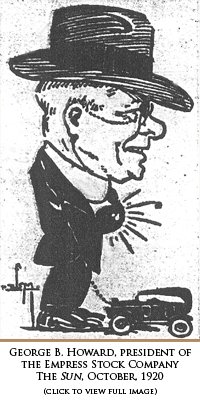 | |||||||||
| |||||||||
Later, all of Alabama's physical and emotional energy is given to the ballet, which she takes from a Russian in Paris. Other dances - the Charleston, for one - might be where the average person chanelled not all, but a part of his/her energy, but the Russian ballet held an irresistible allure for many throughout the world. In Vancouver at this time, there was a significant amount of ballet activity through visits from the Russians, as well as from local dancing schools. Pavlova made three visits during the 1920s: January 25 to 26, 1921, in three performances at the Avenue Theatre with Alexandre Volinine; January 9, 1924, in a matinée at the Orpheum with Laurent Novikoff; and finally on February 23, 1925, in an afternoon and evening performance at the Empress Theatre, with both Volinine and Novikoff, as well as Hilda Butsova (born Hilda Boot in Nottingham, England). It's interesting to note the cooler approach taken in the review of Pavlova's final appearance, which, although highly favourable, has none of the breathless intoxication that flavoured Makovski's prose in 1910. The anonymous Sun reviewer begins his brief report, published on February 24, 1925, by observing, “Ovations were accorded....” and remains throughout an observer more than an impassioned participant. Although we learn that both Volinine and Novikoff were able to catch Pavlova's “every mood,” just what those moods were is not expressed. There was also another visit from Mikhail Mordkin, this time with Vera Nemtchinova, Hilda Butsova and Pierre Vladimiroff, on January 26, 1927 at the Orpheum. The real activity still comes from vaudeville, with its crazy patchwork of dance, song, comedy, melodrama and talented animal artists. A challenge to vaudeville's reign is, however, apparent in another popular kind of entertainment called a revue. (next page)
©2006, Dance Collection Danse | ||||



